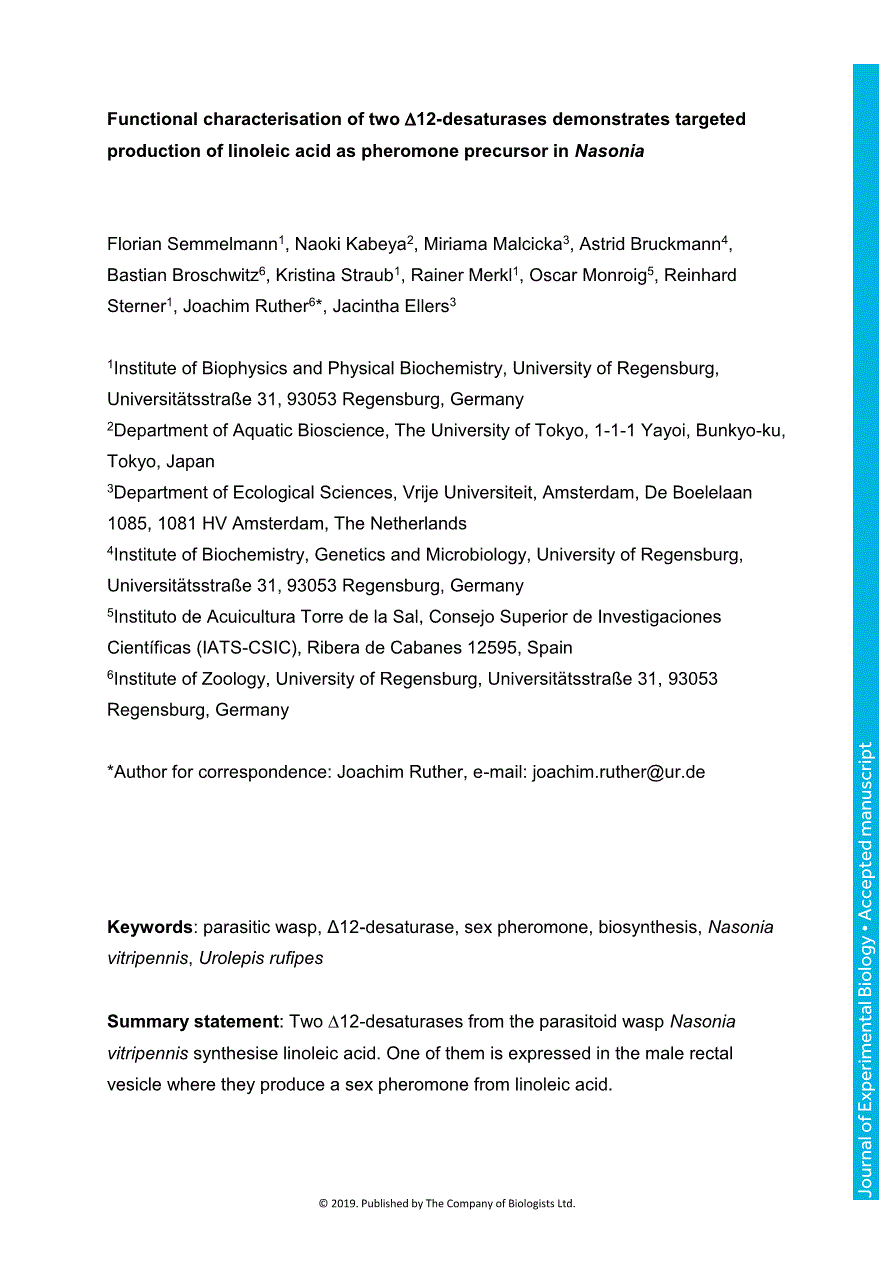Insect pheromones are often derived from fatty acid metabolism. Fatty acid desaturases, enzymes introducing double bonds into fatty acids, are crucial for the biosynthesis of these chemical signals. Δ12-desaturases catalyse the biosynthesis of linoleic acid by introducing a second double bond into oleic acid, but have been identified in only few animal species. Here we report the functional characterisation of two Δ12- desaturases, Nvit_D12a and Nvit_D12b, from the parasitic wasp Nasonia vitripennis (Walker). We demonstrate that Nvit_D12a is expressed in the rectal vesicle of males where they produce a linoleic acid-derived sex pheromone to attract virgin females. 13C-labelling experiments with Urolepis rufipes (Ashmead), a closely related species belonging to the so-called “Nasonia-group”, revealed that females but not males are able to synthesise linoleic acid. U. rufipes males produce an isoprenoid sex pheromone in the same gland and do not depend on linoleic acid for pheromone production. This suggests that Δ12-desaturases, while common in the “Nasonia group”, acquired a specialised function in chemical communication of those species that use linoleic acid as a pheromone precursor. Phylogenetic analysis suggests that insect Δ12-desaturases have evolved repeatedly from Δ9-desaturases in different insect taxa. Hence, insects have developed a way to produce linoleic acid independent of the “Omega”-desaturase subfamily which harbours the eukaryotic Δ12-desaturases known so far.
Functional characterisation of two Δ12-desaturases demonstrates targeted production of linoleic acid as pheromone precursor in Nasonia
Currently Viewing Accepted Manuscript - Newer Version Available
Florian Semmelmann, Naoki Kabeya, Miriama Malcicka, Astrid Bruckmann, Bastian Broschwitz, Kristina Straub, Rainer Merkl, Oscar Monroig, Reinhard Sterner, Joachim Ruther, Jacintha Ellers; Functional characterisation of two Δ12-desaturases demonstrates targeted production of linoleic acid as pheromone precursor in Nasonia. J Exp Biol 2019; jeb.201038. doi: https://doi.org/10.1242/jeb.201038
Download citation file:
Advertisement
2023 JEB Outstanding Paper Prize shortlist and winner

The JEB Editors are delighted to announce the shortlisted authors for the 2023 JEB Outstanding Paper Prize. Read the winning paper - Tiny spies: mosquito antennae are sensitive sensors for eavesdropping on frog calls - by Hoover Pantoja-Sanchez and Brian Leavell from Ximena Bernal's lab at Purdue University, USA.
JEB Science Communication Workshop for ECRs

If you’re an early-career researcher interested in science communication and are attending the SEB Annual Conference in Prague this summer, come a day early and join the JEB Editors at a sci comm workshop to learn the key writing skills needed to promote your research to a broad audience beyond your peers (1 July at 14.30-17.30). Places are limited to 24 attendees, and applicants should apply through the SEB registration page by 30 April 2024.
Bridging the gap between controlled conditions and natural habitats in understanding behaviour

Novel technologies enable behavioural experiments with non-model species, in naturalistic habitats and with underexplored behaviours. In their Commentary, Scholz and colleagues discuss how to obtain a deeper understanding of the natural ecology and lifestyle of study animals.
Beluga metabolic measures could help save species

To help save animals from extinction, it’s important to understand what each species needs to survive. This led Jason John et al. to measure the metabolic rates of captive belugas to develop a ‘fish calculator’ showing that the whales need to eat ~23 salmon per day.
ECR Workshop on Positive Peer Review

Are you an ECR looking for tips on how to write concise, astute and useful manuscript reviews? If so, join the JEB Editors at a 2-hour JEB-sponsored Workshop on Positive Peer Review at the Canadian Society of Zoologists annual meeting in Moncton on 9 May 2024 at 13.00-15.00. There are 25 spaces for ECRs and selection is first come, first serve. To sign up, check the ECR Workshop box when you register for the CSZ meeting.



